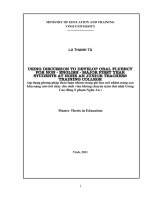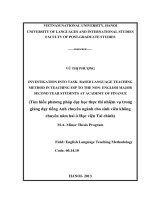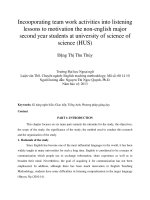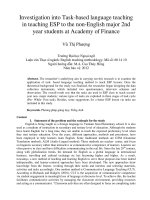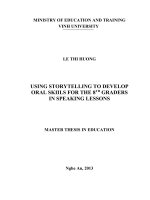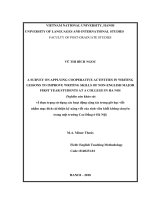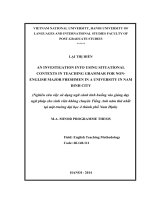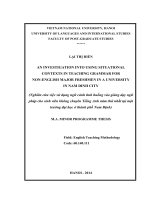Using discussion to develop oral fluency for non english major first year student at nge an junior teachers training college
Bạn đang xem bản rút gọn của tài liệu. Xem và tải ngay bản đầy đủ của tài liệu tại đây (358.09 KB, 78 trang )
MINISTRY OF EDUCATION AND TRAINING
VINH UNIVERSITY
------------------------
Lu Thanh Tó
Using discussion to develop oral
fluency for non - English - major first
year students at Nghe an Junior
teachers training college
(áp dụng phơng pháp thảo luận nhóm trong giờ học nói nhằm nâng cao
khả năng nói trôi chảy cho sinh viên không chuyên năm thứ nhất trờng
Cao đẳng S phạm Nghệ An )
Master Thesis in Education
Vinh, 2011
1
MINISTRY OF EDUCATION AND TRAINING
VINH UNIVERSITY
------------------------
Lu Thanh Tó
Using discussion to develop oral
fluency for non - English - major first
year students at Nghe an Junior
teachers training college
(áp dụng phơng pháp thảo luận nhóm trong giờ học nói nhằm nâng cao
khả năng nói trôi chảy cho sinh viên không chuyên năm thứ nhất trờng
Cao đẳng S phạm Nghệ An )
Field: Theory and Methodology of English Language Teaching
Code: 60.14.10
Master thesis in Education
Supervisor: Dr. Le Van Canh
Vinh, 2011
2
TABLE OF CONTENT
3
CHAPTER I: INTRODUCTION
The teaching of foreign language has traditionally concentrated on making the
students aware of certain aspects of the code (vocabulary, pholological and
morphological features and syntactic rules) without providing adequate practice in the
selection of message and in the process of encoding it for transmission (Rivers,
1968). As a result, later years of study, students have known a great deal about a
foreign language without being able to use it to express their intentions. In recent
years, much of the dicussion relating to proficiency-oriented instruction and testing
has focused on the development of oral skills. The emphasis on speaking proficiency
can be attributed to a variety of factors, many of which are traceable to the
methodological trends and movements and new developments in theory and research.
These are the impetus for a continued interest in oral proficiency. This chapter
introduces the study. It starts with the background and rationale of the study. Then the
aims and objectives of the stucy are presented, which is followed by the presentation
of the research hypothesis, reasearch questions and the methods used for the present
study. Then, the scope of the study is presented. Finally, information about the
structure of the thesis is provided.
1.1.
Background and Rationale
As we all know, for a long time, the traditional teaching methods of English
language such as Grammar-translation, the directed and the audio-lingual has been
used as dominating ways of teaching and learning English in Vietnam.
These methods do not focus on communicative skills, but much on
grammatical points in order to help learners be excellent at grammar, but they can not
communicate with each other English .In classroom, teachers always explain
grammatical points such as tenses, articles, prepositions and so on, and give students
a great deal of exercises to practice in order to master grammar rules. Therefore,
learners rarely have opportunities to speak and express their own ideas. In the
4
teacher-centered class, the teacher tends to explain and students take notes and
practice; they rarely work in pairs or in groups to discuss a topic with each other. This
seems to be very absurd for many educators in the world as the purpose of learning a
second language is to communicate with each other in society. This is a reason why
the Ministry of Education and Training needs to innovate the way of the second
language teaching by applying the communicative approach in teaching English in
Vietnamese classrooms. In addition, the text books and curriculums for both schools
and universities should be designed for the communication-oriented and learnercentered approach. Almost all teachers are required to improved their teaching skills
and try out new method to be successful in classrooms. There is no doubt, discussion
is one of the most effective communicative approaches that teachers often take into
practice.
A number of researches have been conducted in the field in order to realize the
influences of group discussion as a frequent class activity on students’ linguistic
performance and communicative competence. Participating in group discussion helps
students develop “reproductive thinking” into “productive thinking”, and discussion
method results in effective learning outcomes in terns of: (a) the mastery of general
subject, (b) ability of problem-solving, (c) the development of communication skills
( Wilen, 1990).
Alvermann and Hayes (1989) believed that active and thoughtful participation
in class discussion in an “outward sign of leaning”. Besides, in group participants
learn to talk better, i.e. they know how to retrieve ideas, organize them coherently and
speak them out fluently; therefore, communication competence is developed.
Discussion also shapes “moral culture” as participants act together in a special way
with regard to truthfulness, responsiveness, openness, respect, self-awareness, selfconfidence and so on (Bridges, 1979). However, Jones (1999) raised a question why a
number of non-native English speaking background students, particularly those who
come from Asian countries, encounter difficulties in academic group discussion. They
5
stay silent and reticent whilst their counterparts from Europe, for example, actively
participate in the group work.
In sum, group discussion is regarded as a fruitful topic for researchers,
particularly for those who are interested in Second Language Acquisition in the sense
that is relates to how L2 learners approach a new language and how interactions
among them contribute to that process. A number of researchers have shed light onto
the field and seemed to agree on the point that group discussion productively
promotes interactions among its participants. Although many of the researchers did
investigate the issue, few have drawn the conclusion about what truly happens during
group discussion and whether there are the relation ships between group discussion
and its influence on the participants’ speaking skill in terms of accuracy. Moreover,
the most important reason why I pursue the study on group work is that teachers
comes at the Nghe An Junior Teachers Training College have been using group
discussions very so often , however , they do not truly recognize how much their
students may benefit from this dynamic activity. A minority of them even show
doubts on group discussion’s possibilities .Being inspired by the teaching situation in
the Nghe An Junior Teachers Training College , the researcher comes up with the
project with clear purposes in mind: to go deeply into the essence of group discussion
to explore what the students actually do during group discussion and its impacts on
students’ acquisition of communicative competence in terms of accuracy , to
determine if there is any possibility that participating into discussion for academic
purposes can help students gain better at their interactions within the classroom,
inside the college campus and later on in a learning environment of other higher
educational institutions. In addition, nothing is absolute. The activity of group
discussion is necesarrily accompanied with constraints, which encourages me a lot to
find out the key to it. Surely, my intimate goal through all of such efforts is
ditermining the fittest activity of fostering non-major first year students’ English
competence at Nghe An Junior Teachers Training College.
6
1.2.
Aim and Objectives of the Study
The aims of the present study are (1) to investigate the extent to which group
discussion activities can help to reduce the students’ speaking anxiety, and (2) to find
out the students’ reactions to group discussion activities for the development of their
speaking skills. Thus, the study is designed to achieve the following objectives
* To find out the possibilities of using group discussion activities in the
context of large classes of Nghe An Junior Teachers training College;
* To find out the students’ attitudes towards speaking English as well as the
factors affecting their participation in speaking activities;
To gain students’ opinions on how group discussion activities enhance their
participation in speaking activities in the classroom.
1.3.
Research Questions
In order to achieve the above-mentioned aims and objectives, the study was
designed to seek answers to the following research questions:
1: What are the student’s opinions of the benefits resulted from participation
in group discussion activities to the development of their oral fluency?
2: What do the students like and dislike about discussion activities?
3: What are their suggestions for improvement in using discussion in speaking
lessons, if these activities can be continued in the classroom?
By answering all these research questions, it is hope that the study will shed
light on whether group discussion activities can be used as an instructional strategy in
the context of large classes and students’ low proficiency in English, and if they are
appilcable, how they can be used.
7
1.4.
Method of the study:
This study is a small-scale action research project, and it is conducted with a
quantitative methodology. Before group discussion activities were designed and
applied in the classroom, a questionnaire was administed to the researched students to
find out the factors affecting their participation in classroom speaking activities. On
the basis of initial analysis of the students’ responses to the questionnaire, group
discussion activities were designed and applied in the classroom. During the
intervention, the researcher observed the students and took notes of important issues
emerging during the intervention, such as the students’ attitudes, their interactions,
and linguistic difficulties. After the treatment, another questionnaire was administed
to the same groups of students. The purpose of this post-intervention questionnaire
was to find out how the students evaluated the impact of group discussion activities
on their speaking skills.
All the responses from both the questionnaires were analyzed quantitatively by
means of descriptive statistics. Data were then tabulated for discussion.
1.5. The Scope of the Study
The present study, which is an action research project in nature, is limited
itself to the investigation of how the application of group discussion activities helped
to reduced the students’ anxiety in speaking English as well as their self-evaluation of
the benefits of participating in group discussion activities to their speaking skills.
Although part of the study was somehow like an experiment, i.e., the application of
group discussion activities, the study is by no means experimental. This is because
the purpose of the study is not to establish the cause-effect relationship between
variables, i.e. between the application of group discussion activities and the students’
oral proficiency. Rather, the study is aimed at determining whether group discussion
activities can help to reduce the students’ anxiety in speaking English, thereby
increasing their participation in classroom speaking activities. This means that the
8
causal relationship between students’ participation in group discussion activities and
their oral proficiency is beyond the scope of this study.
1.6. The Design of the Thesis
This thesis is organized into five chapters
Chapter One has briefly introduced the general background information, the
scope, objectives and methods dealt with in the study. Research questions will also be
raised in this chapter. Chapter Two – Literature Review - will start with some
definitions of group discussion, then review a number of studies on pre-task strategic
individual planning and its consequences on task performance in terms of fluency,
complexity and accuracy. Chapter Three, the methodology chapter, will make it
clear how the present study was implemented, including information about context,
participants , and procedures, instrumentation and data collection. Methods of
analysis will be addressed in Chapter Four. Analysis of a range of data collected
from various sources (oral data from group planning and individual presentations,
teacher’s observation notes ) for the study will be clarified in this chapter.. These
results will be discussed and interpreted in Chapter Five, which is also the
concluding chapter of the study.
1.7. Summary
This chapter introduces the study. This introduction includes the background,
the rationale, the research questions, research methods, and the scope of of the study.
Next chapter reviews the literature for the study.
9
Chapter II: LITERATURE REVIEW
This chapter reviews the literature on teaching speaking skills in foreign
language education with particular reference to discussion as a classroom activity that
aims at developing students’ oral competence.
2.1. What is Speaking?
Mackey (1965) summarizes oral expression as follows:
Oral expression involves not only [....] the use of the right sounds in
patterns of rhythm and intonation, but also the choice of
in the right order to convey the right meaning.
the right
words and inflections
(p. 266)
According to the above definition, Mackey emphasizes doing things ‘right’ in
order to be any good at speaking: choosing the right forms; putting them in the
correct order; sounding like a native speaker; even producing the right meanings. This
views of speaking influences the list of exercises which Mackey discusses: model
dialogues, pattern practice, oral drill tables, look-and-say exercises, and oral
composition. However, critiques argue that this is a bit like learning to drive without
ever going out on the road (Bygate, 1987).
Ten years later after Mackey’s work was published, Wilkins (1975) pointed
out there were some learning problems that exercises like these did not solve. An
important one is that of ensuring a satisfactory transition from supervised learning in
the classroom to real-life speaking. This transition is often called the ‘transfer of
skills’. As Wilkin points out, if all language produced in the classroom is determined
by the teacher, ‘we are protecting [the learner] from the additional burden of having
to make his own choices’. He continues:
As with everything else he will learn only what falls within his experience. If
all his language production is controlled from outside, he will hardly be competent
10
to control his own language production. He will not be able to transfer his
knowledge from a language-learning situation to a language-using situation.
(Wilkins, 1975, p. 76, emphasis added).
The point Wilkins makes is that the skill of controlling one’s own language
production and having to make one’s own choices should be developed. This kind of
skill is called interaction skill (Bygate, 1987). Interaction skills involves making
decisions about communication, such as: what to say, how to say it, and whether to
develop it, in accordance with one’s intentions, while maintaining the desired
relations with others. Thus, interaction skills involve the abiity to use language in
order to satisfy particular demands. Richards (1990) divides interaction skills into two
categories: interactional skills and transactional skills. The former refers to the ability
to use language to establish and maintain social relationships while the latter refers to
the ability to use language to get things done.
Bailey (2005) defines speaking consists of producing systematic verbal
utterances to convey meaning. Utterances are simply things people to say. Bailey also
cites Florez (1999, p. 1), who views speaking as “an interactive process of
constructing meaning that involves producing and receiving and processing
information”. Thus, the most distinctive feature of speaking is interactive. Speakers
need to have something to say that interests the listener. Also the speaker has to
understand his or her interlocutor and respond appropriately to what the interlocutor
says. Discussion, a verbal activity in which participants express their own views and
respond to others’ ideas verbally, is one of oral activity. In the foreign language
classroom context, discussion is one of the activities that teachers can use to develop
the students’ speaking.
2.2.
Role of Speaking in Second/ Foreign Language Learning
Bygates (1987) points out that
11
Speaking is ... a skill which deserves attention every bit as much as
skills, in both first and second languages. Our learners often
literary
need to be able to
speak with confidence in order to carry out many of their most basic transactions. It is
the skill by which they are most frequently judged, and through which they may make
or lose friends. It is the vehicle par excellence of social solidarity, of social ranking,
of professional advancement and of business. It is also a medium
through which
much language is learnt, and which for many is particularly conducive for learning.
Perhaps, then, the teaching of
speaking merits more thought.” (p. vii, emphasis
in the original)
According to Rivers (1968) the early introduction of the speaking of the
language is important for reasons of motivation. She explains that students come to
the study of a foreign language in the school with the strong conviction that language
means something spoken. Contemporary communicative language teaching
approaches emphasize the importance of having students engage in “tasks” that
encourage meaningful interaction (e.g. Long, 1985; Nunan, 1989; Gass, 1997;
McDonough & Mackey, 2000). Recent research in second language acquisition has
also considered oral interaction as an important factor in the shaping of the learner’s
developing language. She, thus advises that students in a foreign language class will
not learn to speak fluently merely by hearing speech, although this is important in
familiarizing them with the acceptable forms of the code.
Ur (1996) points out that “[O]f all the four skills (listening, speaking, reading
and writing), speaking seems intuitively the most important: people who know a
language are referred to as ‘speakers’ of that language” (p. 120). She goes on to add
that “Classroom activities that develop learners’ ability to express themselves through
speech would therefore seem an important component of a language course” (p. 120).
Recent research in Second Language Acquisition (SLA) has also considered oral
interaction as an important factor in the shaping of the learner’s developing language.
A number of studies have investigated the role of interaction in second language
12
development, particularly in conversations between native and nonnative speakers
and among nonnative speakers working in pairs or small groups (for a review of some
of this research, see Gass, 1997). Swain (1985, 1995) has also highlighted the role of
output in language learning and described a variety of communication activities that
can help learners develop accuracy as well as fluency through consciously reflecting
on their language production. Her output hypothesis is based on the idea that
understanding language and producing language are different skills, and that the
second can only be developed by pushing the learner to produce output – actually to
say and write things. This is indeed the notion of interaction. When a learner interacts
with someone – it may be another learner or a teacher – the learner receives input,
and produces output. The Interaction Hypothesis is associated, for foreign language
learning, with Allwright (1984) and Long (1983). The hypothesis claims that it is in
the interaction process that acquisition occurs: learners acquire through talking with
others.
From the learners’ perspectives, research has indicated that many second and
foreign language students consider speaking ability one of their primary goals of
study (Harlow & Muyskens, 1994), either because they would derive some personal
satisfaction from being able to speak a second language or because they feel it would
be useful in travel or in pursuing other interests or career goals.
It is clear that oral proficiency in a second and/or foreign language can be an
important asset for anyone seeking employment in business and industry in the
twenty-first century (Hadley, 2001). For these reasons, it is incumbent upon us as
language teachers to identify some effective strategies for teaching oral skills that will
maximize opportunities for the development of useful levels of proficiency. Among
these instructional strategies, discussion is strongly recommended (Bygate, 1987; Ur,
1996).
13
2.3
Teaching speaking skill
Speaking plays a signicant role in teaching and learning a foreign language. It
is not only helps students know how to read, to write and to listen but also know how
to communicate with Engish speaking people. It is underniabe that the speaking
ability is a good source of motivation for most students. Many students equate being
able to speak a language to knowing the language. Therefore, they view learning the
language as learning how to speak the language. According to Nunan (1991), success
is measured in terms of the ability to carry out a conversation in the target language.
Adiitionally, in the speaking class, if the right activities are taught in the right
way, speaking can be a lot of fun, raising genalral learners motivation and making the
Engish language classroon a nice and dynamic place to be
2.4
Challenges of Teaching Speaking to Students
Developing the students’ ability to speak in a foreign language is an extremely
difficult and arduous task. This is because the acquisition of speaking involves the
mastery of the different language subsystems to the point that they can be employed
automatically in spontaneous communication, simultaneous focus on comprehension
and production. These subsystems are difficult for the students to acquire because of
limited attentional resources as well as the impact of a wide range of social factors
that often determine successful attainment of communicative goals (Pawlak, WaniekKlimczak & Majer, 2011).
Horwitz (2008) states that speaking is the aspect of second language learning
most often associated with anxiety, and both students and teachers experience anxiety
in a speaking lesson. She goes on to explain that nonnative teachers may also be
anxious about speaking and avoid conversational activities. In several studies, I found
that anxious pre-service language teachers did not expect to use communicative
teaching methods even though they believed that those were the best language
14
teaching methods available. Even native teachers may become anxious when no one
volunteers to participate in a speaking activity (p. 98)
Thus, student participation is one the many reasons for teacher anxiety in
teaching speaking activities.The challenge is further compounded in a situation in
which learners have rather limited access to the target language both inside and
outside the classroom, which is the norm in the majority of foreign language contexts
including Nghe An Junior Teacher College. For this reason, there is a need to explore
issues connected with teaching and learning speaking with a view to translating the
theories into context-sensitive pedagogical practices.
Burns and Seidlhofer (2010) point out,
… learning speaking, whether in a first or other language, involves
developing
subtle and detailed knowledge about why, how, when
communicate, and complex skills for producing and
to
managing interaction, such
as asking a question or obtaining a turn. (p. 197)
Such difficulties, in turn, inevitably generate a number of problems for
teachers, particularly those in foreign language settings, as they have to create in their
classrooms optimal conditions for the acquisition of all the components of the skill of
speaking as well as ample opportunities for contextualized, meaningful and integrated
practice in using it (Pawlak, 2011, pp. 4-5).
Bygate (2009) breaks the spoken language down into (1) the spoken
repertoire, (2) the conditions of speech and (3) the processes of oral language
production. The first category includes a range of linguistic elements, which can be
subdivided
into
phonological
(i.e.
both
segmental
and
suprasegmental),
lexicogrammatical (morphological and syntactic resources, lexis, as well as formulaic
and pragmalinguistic units) and discourse features (i.e. socio-pragmatic features and
pragmatic discourse structures), and different constellations of which are used with a
view to attaining social or informational purposes in specific situations. Broadly
15
speaking, these purposes are related to three overarching functions of oral discourse,
namely interactional (i.e. maintaining social relationships), transactional (i.e.
conveying information) and ludic (i.e. using language for entertainment) (Brown &
Yule, 1983; Tarone, 2005).
According to Pawlak (2011), there are situations where learners have virtually
no opportunities for developing the speaking skill due to frequent reliance on the L1,
teacher-fronted classes with rigid control over all classroom discourse or excessive
preoccupation with other skills and subsystems such as grammar and vocabulary. The
teaching of speaking is likely to be limited to activities such as role-plays that
students recite from memory or exchanges that require minimal output. All these have
little to do with authentic communication. These problems testify to the challenges
involved in teaching speaking but at the same time point to the urgent need to find
ways to develop the students’ speaking skill effectively in response to learner
expectations and course objectives.
2.5. Factors affecting students’ reticence in speaking classes
There are many factors that affect the students’ participation in speaking
activities in the foreign language classrooms, and this poor participation is often
termed as student reticence. One of those factors is the anxiety generated over the risk
of saying something wrong, stupid or incomprehensible (Brown, 2001). Language
classroom anxiety has been pointed out by many scholars and researchers. Horwitz,
Horwitz and Cope (1986) define language learning anxiety as “a distinct complex of
self-perceptions, beliefs, feelings, and behaviours related to classroom language
learning arising from the uniqueness of the language learning process” (p. 128).
Another factor is the students’ low English proficiency. They feel they do not have
enough vocabulary and grammar to get the intended message acrosss. Low
proficiency makes the students less confident and afraid of making mistakes. Many
researchers have pointed out that students’ negative attitudes toward speaking English
in the classroom, low language proficiency, anxiety, leraning styles or lack of practice
16
might be the key factors for the students’ non-participation in classroom speaking
activities (Flowerdew & Miller, 1995; Yu, Liu, & Littlewood, 1996).
Shrum (cited in Horwitz, 2008) suggests that if language teachers allowed
more time between their original questions and talking again, language classrooms
would become substantially more communicative. She found that classes where the
teacher waited longer contained higher percentages of target language talk and lower
percentages of first language talk. Interestingly, Shrum found that language teachers
actually gave students more time to answer questions in the first language than in the
foreign language. She suggests that it is reasonable to allow students to think for at
least four or five seconds before stepping in and offering a response or posing a new
question.
Thus, organizing group discussion activities for the students in a speaking
lesson is to give them more time to think over what they want to say. This may help
to increase their participation in the classroom speaking activities.
2.6.
Group discussion and its advantages
2.6.1. Definition of group discussion
First, let’s examine the different definitions of group discussion
“group discussion is an activity in which students usually interact with one
another (often face to face) with the goal of increasing understanding, and achieving
shared solutions to a particular probem,” (Brilhart & Galanes, 1992). This difinition is
simiar to Henry’s: “Group work is a number of people interacting in a face to face
situation” (Henry, W. 1997). According to Dillon, group discussion is also defined as
“a form of bask-and-forth interactions, give-and-take diaogues in which participants
enrich, refine and exchange their understandings, facts, opinions, experiences and the
like” (Dylon, 1994).
17
Another definition of group work is given by Brown, D: “ It [group work] is
generic term term covering a multiplicity of techniques in which two or more students
are assigned a task that involves colaboration and self initiated language. It implies
small group work, that is, students in groups of perhaps six or fewer” (Brown, 2001,
page.177). Thus, three important aspects should be highlighted in these definitions.
The first one is colaboration, in other word, cooperation. Students have to work
together to complete the task. All the members of the group are liked the piece of a
machine. If one does not work well, a trouble may occure. In group work, of course,
all the member discuss together, come out with new ideas, chage certain things, but if
one does not comply with his or her role, the work will be parralised. Also, roles are
changed within the group every time when a new task is assigned. This is what Kagan
(1994) called “interdependancy”. “The success of every team member depends on the
success of each member (if one fails, all do), then a very strong form of positive
interdependency is created and team members are very motivated to make sure each
student does well” (p.7). the second and the third aspects are very related. Self initiated
language refers to students using what they have known and learnt to communicate in
the classroom. In order to do this, the groups have to be small, as Brown (2001)
previously suggests six students or fewer. In a very bid group, shy or passive students
tend to fall in silence and let the most talkative ones do the talking. Nunan (1999) also
points out that one of the classroom variables that have had a marked effect on students
participation on oral activities has been group size. Studnets who remain silent in group
ten or more will contribute activily to discussion when group size is reduced into five
or three (p. 157)
There are also some other definitions about group discussion.
Doff (1988,p.137) defines group work as a process that “ the teacher divides
the class into small group to work together(usually four or five students in each
group),all the groups work at the same time.”
18
According to Richard(1983,p.189),group work is an essential activity because the
kind of interactions produced in group activities has been shown to be quantitatively
as well as qualitatively different form that which goes on in the teacher-dominated
lessons.
It is obvious that group work is a co-operative activity, during which students
share aims and responsibilities, they have chances for greater independence as they
take some of their own leaning decisions without the teacher controlling every move.
And they can work without the pressure of the whole class listening to what they are
doing. In addition, students have many chances to interact with each other.
2.6.2. Benifits of group work
It is clear that putting students into small groups in the classroom will open up
for them possibilities of interaction which are not ussually available in a whole-class
approach. Group work offers many chances for co-operation,through which students
share responsibilities,give their own learning decisions and learn from each other.
They learn to negotiate, learn to listen different opinions. They feel more equal to
participate in group work and free to experiment and use the language.(Brown,2001).
According to Brown (2001), there are four typical benifits of group work:
2.6.2.1. Group work generates interactive language
The teacher talk is really dominant for along time in so-called traditional
language classes. The teacher lecture, explain grammar points,conduct drills and
spend a little time for whole class discussions in which each student might have a few
seconds of class period to talk. With traditional methods, the teacher tends to be the
only person who initiates language in an artificial setting and the whole-class
becomes a group “interlocutor”. Thanks to group work, student’s opportunities for
language practice as well as interaction are increased. In other words, students have
more chance to speak English in the classroom.
19
2.6.2.2. Group work offers a positive affective climate
The second important benefits offered by group work is to make learners feel
secure when speaking on public. It is a nightmare for many students, especially the
shy ones when being called to speak in front of the class and the teacher. Their mind
becomes completely emty and even they cannot say a word. Nevertheless, a small
group of peers provides a relatively intimate setting and a more supportive
envirnment in which they will find it much easier to share their points of view in a
natural way.
2.6.2.3. Group work promotes learners’ responsibility and autonomy
The whole-class activities often gives studens a lot of time to relax even in a
small class of fifteen to twenty students. But when they participate in group work
which places responsibility for action ang progress upon aech of the members of the
group equally,it is difficult for them to “hide” in a small group. In addition,group
work allows students to make their own decisions in the group without being told
what to do by the teacher.
2.6.2.4. Group work is a step toward individualising instrution
Each student in a classroom has different language needs and ability.
Therefore, the teachers have some difficulties in managing the class with students at
different levels of language. But small groups can help students with varying abilities,
another kind of individual difference among students are their age, sex, attitude,
motivation, aptitude, personality, interests and anguage learning experience which
can also be solved by group work. When organizing the class, the teacher can
recognize and capitalise upon these differences by careful selection of small groups
and by administering different tasks to different groups.
2.6.2.5. The implementation of group work in the classroom
20
According to Brown (2001), if group work is not carefuly planned, well
executed, monitored thoroughly and followed up on in some ways, it can go wrong.
The following are practical steps suggested by him to take to carry out successful
group work in the classroom.
2.6.3. Group work and its benefuts from different points of view
For decades, group discussion as a teaching tool has drawn substantial
attention from researchers. Studies of how language is learnt in groups stemmed from
different perspectives. Group work has been investigated from the psycho-linguistic
theoretical perspective (e.g. Gass and Varonis, 1994; Loschky, 1994; Ellis et at,
1994), with researchers focusing on the kind of negotiations that group work
encourages. Research guided by socio-cultural theories of learning (e.g. Donato,
1994; Storch, 2001, 2002) has focused on how language knowledge is co-instructed
in group or pair interactions. However, regardless of the theoretical perspective
adopted, it has been widely agreed that
group discussion is a worthwhile and
beneficial activity in the classroom, and therefore should be encouraged. In addition
to theoretical arguments, pedagogical arguments for the practice of group work in the
classroom can be found in the work of Long and Porter (1985).
2.6.3.1. From the psycho – linguistic point of view
Researchers (Long, 1985; Gass and Varonis, 1994; Loschky, 1994; Swain and
Lapin, 1995; Fuente, 2002) have shed more light on the negotiation of meaning and
oral L2 development from psycho-linguistic perspective. The negotiation of meaning
refers to the conversational modifications and adjustments between participants when
they encounter a breakdown in communicative interactions. Long(1985) argues that it
is not input nor interaction that is important to the L2, but input that occurs in the
interaction where meaning is negotiated through interactional modifications.
Following the argument of Long, an investigations of non-native speaker/non-native
speaker(NNS/NNS)
interactions
have
21
received
attention
in
recent
years(Foster,1998;Lynch&Maclean,2000). From the reseach findings of NNS/NNS
interactions, the use of tasks and group work has been found to provide the learners
with more opportunities to produce the target language and to mordify interactions,
and to espose the learners more comprehensive input,which in turn results in L2
acquisition. These reseachers suggest the interaction should advantage students to use
new words if they have chances to use/repeat the words and receive feedback from
others speakers.
2.6.3.2.From the socio-linguistic points of view
Group work has also been examined from a socio-cultural perspective. This
perspective stems from Vygotskian theory of cognitive development and
learning(1978). Human cognitive development is argued to be socially situated by
means of language, a mediating tool in interaction with other poeple.
Knowing/learning is therefore believed to be co-construced in and developed through
social interactions between people, and only then internalized within an individual.
Following Vygotsky’sdevelopmental theory, Donato(1994) explored “collective”
group interaction by learners of French and their language performance in an openended classroom task. During one-hour planing section, these students had to prepare
for conclusion of a given scenario; then they were asked to present their scenario
conclusion before the class. Donato found that group work can promote L2 learning
by means of collective scaffolding. The term “scaffolding”, originating from sociocultural theory and L1 reseach, means the supportive condition whereby a more
knowledgeable participant assists another less skilled participant to develop to a
higher level of proficiency. Collective scaffoding is a “strategic process of problem
solving” in which at first an “expert”/experienced individual “guides, supports, and
shapes actions” of the novice/less able individual. The novice then can internalize the
processes and be able to perform him/herself even when support is no longer
available (Donato,1994;37). Donato ‘s (1994) findings sugested that learners,by
means of collective scaffolding , could support each other in finding the best solutions
22
to L2 problems during collaborative interactions. Other reseachers (e.g . Ohta,2001)
also found envidence of collective scaffolding in group work among L2 Japanese
learners.
Furthermore, Dorato(1994) found that such collective scaffolding may
facilitate L2 individual’s linguistic development.Students who had engaged in the
previous “collaborative planning”/scaffolding processes were reported to be able to
use a relatively high percentage of scaffolded items(24 out of 32 scaffolded cases) in
subsequent independent performance when supporting conditions were no longer
available.The findings provided convincing evidence to support the role of social
interaction in individual’ linguistic development. This is similar to findings reported
by Ohta(2001). Scaffolding during learners’ interactions was believed to build
“bridges to proficiency” and support second language development.
In line with Dorato’s study, Scorch’s(2002) longitudinal classroom-based
study in an aldult ESL class also found that students could scaffold each other when
interacting in pairs. However, Scorch found that such scaffolding occurred more
frequently in certain patterns of pairs interactions(collaborative and expert/novice).
There was also evidence of a transfer of language items co-constructed in these
patterns of pair work to the subsequent individual performance. The reseacher
referred to Vygotskians theory to interpret such findings. That is, interactions in
collaborative and expert/novice patterns helped co-construct language items. These
items were then internalized by individual members of the pairs, and re-produced in
subsequent performance. The reseacher also posited that patterns of pair/group work
might relate to language learning, and therefore the nature of pair/group work could
not be neglected when studying learners’ interactions. This empirical evidence may
therefore have important pedalogical implications for L2 learning in ESL contexts.
2.6.3.3. From the pedalogical point of view
23
For the past several decades, the pedagogical arguments for the practice of
group activities in second language learning have been mainly about the relationship
between group work and learner’s interlanguage improvement. Several arguments
concerning the advantages of conducting group work in the language classroom were
proposed by Long& Porter(1985). Firstly, they argued that group work created more
opportunities for learners to practise the second language (L2) in the classroom.
Secondly, that actively engaging in group work appeared to help students improve
their oral language quality because students have wider access to a range of language
function (rhetorical pedagogic, and interpersonal). Long and Porter also suggested
that group activities could also minimised the differences between learners (attitudes,
personality, interest, cognitive styles, first language, learning experience, cutural
background), reduce stress among students and promote supportive envirnment in the
classroom. Group discussion was also considered a means of bringing about a safe
and friendly environment for students to share ideas together, maximizing timid
student’s participation, creating chaces of helping each other in the group, lessening
burden for teachers and subsequently, developing students’ oral communication
skills. Pringle and Freedman (1990) suggested that small group work has potentially
cognitive and social benefit in the long run (Eg. Better reasoning strategies, improved
collaborative skills, better critical thinking).
2.7. Developing Students’ Oral Skills in the Classroom
Nunan (1991) writes, "success is measured in terms of the ability to carry out a
conversation in the (target) language." Therefore, if students do not learn how to
speak or do not get any opportunity to speak in the language classroom they may
soon get de-motivated and lose interest in learning. On the other hand, if the right
activities are taught in the right way, speaking in class can be a lot of fun, raising
general learner motivation and making the English language classroom a fun and
dynamic place to be.
24
For many years people taught speaking by having students repeat sentences
and recite memorized textbook dialogues. Audiolingual repetition drills were
designed to familiarize students with the sounds and structural patterns of the target
language or the language learners are aiming to learn). People supposedly learned to
speak by practicing grammatical structures and then later using them in conversation.
Audiolingualism is based on the concept of habit formation of behaviourism. Since
learners needed to form good habits, lessons involved a great deal of repetition.
Students were not supposed to form bad habits, so teachers treated spoken errors
quickly. Teachers worried that if errors were left untreated, the students might learn
those erroneous forms.
For many years, teaching speaking involved providing students with the
components of the language, in hopes that they would eventually put them all
together and speak. So students might spend most of the class time repeating after the
teacher, studying grammar rules, reciting dialogues, and learning vocabulary.
During the late twentieth century, second language acquisition” research made
us reconsider some long-standing beliefs about how people learn to speak. This kind
of research gave birth to an approach called communicative language teaching (CLT).
CLT can be seen as a set of “principles about the goals of language teaching, how
learners learn a language, the kinds of classroom activities that best facilitate learning,
and the roles of teachers and learners in the classroom” (Richards, 2005, p. 1).
However, Richards goes on to maintain that there is still no single or agreed upon set
of practices that chracterize current communicative language teaching” (Richards,
2005, p. 24). Rather, he suggests that communicative language teaching these days
refers to a set of generally agreed upon principles that can be applied in different
ways, depending on the teaching context, the age of the learners, their level, their
learning goals.” (p. 24)
These principles, according to Brown (2000), include the following:
25
